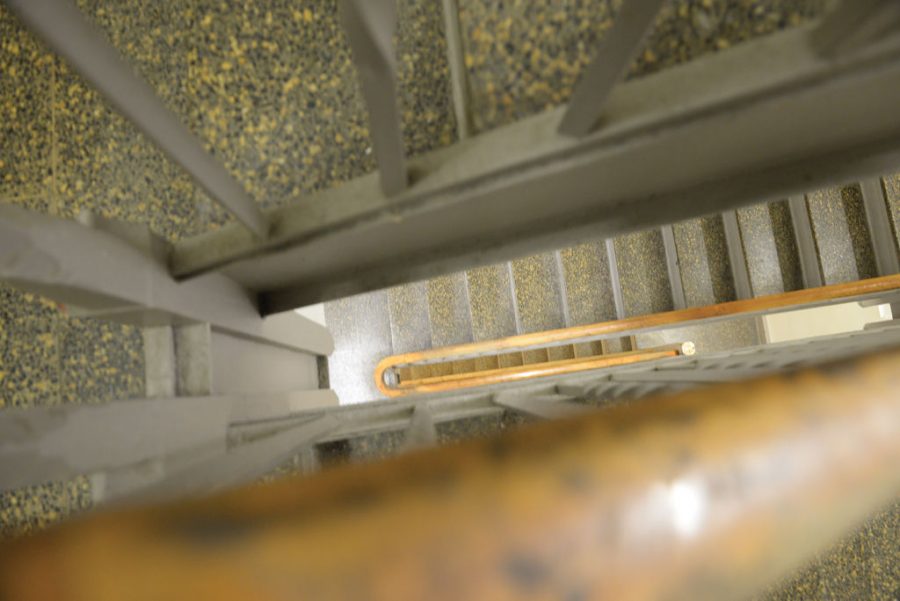Trek to the Top: Cathy Climbers
January 21, 2015
The 764 steps in the Cathedral of Learning break down into 36 flights of approximately 21 steps each.
I know this, because I’ve climbed every one of them.
I’m not the only one, though. Danny Chew, a lifelong Pittsburgh resident, currently holds the record time for climbing the Cathedral stairs — three minutes, 38 seconds. He is one of a group of Pittsburghers who Chew calls “the stair climbers,” as they regularly use the stairs as a form of exercise. It’s a physically rewarding yet grueling experience, which causes Chew to endearingly call the Cathedral the “Tower of Pain.”
I came prepared to join their ranks. I exchanged my jeans and blouse for sweatpants and sneakers and re-tied my laces as the smells of coffee and pastries from the Cathedral Cafe wafted to my nose as I stood on the ground level. I restrained myself. Food would be waiting for me as my reward. It was the first day of classes, Jan. 5. It was freezing outside but the Cathedral stairwell was hot, as usual.
As a frequent runner, I expected the climb to be like any other workout. However, the heat, elevation and unusual repetitive motion made the trek more grueling than expected.
I took my first step, and hoards of students poured through the outside door on the west side of the building. Some looked at me strangely, wondering why I was poised for a workout, but most ignored me and continued on their way. I quickly shuffled along with them.
3rd floor – 12th floor:
It turns out I chose the wrong staircase. I reached the third floor only to find a dead end, forced to abandon my path. I wandered around the halls, admiring the view of the Christmas trees illuminating the Commons from below, as I peered over an open ledge to scan for one of two staircases that continued to the fourth floor.
Once found, my new stairwell was better lit, with the sun streaming through the windows. It was almost pleasant, but I rounded the corner and faced another dead end in this medieval labyrinth.
The third staircase was dark, dank and steep. The number of stairs in each flight had increased, I thought, and there were three flights, instead of two, between floors.
My feet were grateful that I brought a change of running shoes, but my back regretted the decision as I lumbered on with books, a laptop and a spare set of clothes strapped to my shoulders.
My hands clenched the rail.
Signs posted on each floor reminded me that I should use stairwells in case of emergency, and not as a form of exercise.
Most people in the staircases, I found, ignored this demand as they lunged upward, and I only found out the sign’s purpose days after my indoor hike.
Rebecca Findle is one of those scurrying forms ignoring the warning and climbs the stairs once every few weeks in the winter.
“In the winter, on the extra cold days, I opt to run the stairs instead of outside,” Findle, a junior nursing student, said. “I prefer the stairs over a treadmill, and it’s a fast and challenging workout.”
Nicholas Sullivan sprints the stairs for extra cardio after an outdoor run.
“I use the stairs for exercise because it’s a great workout. Stair running is great because it’s like a neverending hill workout. It’s even better, though more tiring, after running outside,” Sullivan, a sophomore neuroscience major, said. “This helps me get an even better workout and will hopefully be beneficial to my marathon training.”
As a “Cathy Climber” all-star, Chew has traversed the equivalent length of a marathon on the Cathedral stairs in just one workout. In a record-setting trial, Chew, 52, ran up the Cathedral stairs for 24 consecutive hours in 2009. By the time he had finished, the horizontal distance he ran was at least 26 miles. A marathon is 26.2 miles.
“When you’re doing a 24-hour record, the intensity isn’t as high, and you have to eat to keep your energy up. I would have food waiting for me on the top floor and would eat as I went down the elevator,” Chew said.
I reached the 12th floor after eight minutes.
I saw a person clad in a pantsuit and heels coming toward me. Observing my sweaty face and athletic attire, she scooted to the other side of the stairwell, with her head hanging down, as she passed me.
I was acutely aware of how my hair must look, matted to my forehead. I rushed to create more distance between the two of us, anxious to get to the top, partly so I could take a break and partly to avoid any more uncomfortable encounters.
The windows were absent from these stairwells, making the pale brown walls seem even darker.
A woman passed me while carrying a bag of groceries. Where had she gotten them in the middle of this building?
I spotted another University sign, with the same warning as before.
Thirty years ago, when Chew first started hiking the stairs, these signsdidn’t line the stairs.
“They’re probably there because the University doesn’t want to get sued in case anyone gets hurt. But I haven’t had any accidents, and if you fall down, you’re not going to get hurt because you’re not going at high speeds,” Chew said.
The University “installed the signs about 15 years ago to inform users that the stairwells were not monitored for physical activity,” according to spokesperson John Fedele, “and to reduce the University’s liability in the event that the stairwells were used as such.”Unlike Chew, climber Findle isn’t as confident in her ability to reach the top unscathed.
“People kind of look confused and concerned [when I pass them], especially because I’m not graceful and probably look like I’m going to drop at any second,” Findle said. “I try to run with a friend, just in case.”
Despite the signs, Findle and Sullivan said University officials have never approached them. A security guard once asked Chew to leave several years ago, he said, though he neitherreceived nor requested an explanation for this.
“I don’t think the stair climbers as a group ever got written permission, but we don’t want to get kicked out, so we don’t want to piss them off,” Chew said. “If someone asks me why I’m there, I would tell them honestly.”
Chew runs the stairs as training for cycling, he said. Regardless of his already impressive records, his goal is to ride one million miles on his bicycle before he turns 70.
According to his website, he biked his 700,000th mile in April 2012 at age 49.
“If I want to train indoors, I’d rather be running stairs than riding a stationary bike, because the [stationary bike] is so boring and doesn’t count toward my miles. It also offers less resistance [than a normal cycle],” Chew said.
True to Chew’s words, I certainly wasn’t bored as I lifted my feet toward yet another flight, feeling the pain in my thighs and calves intensify with each step up.
24th – 32nd floor:
I had to abandon my staircase in search of fresh air. I pushed open the doors and found my first window in what felt like ages, but had actually only been ten minutes. It was opened a crack, and I pushed my face down toward the gap, trying to take in as much cold air as I could.
My breath was coming in large gasps. I reached toward my backpack to pull out my water bottle but decided against unpacking the overstuffed bag.
Taking a few more gulps of air, I prepared for the final leg.
My destination:
Finally, painfully, I collapsed on the stairs in front of the elevators on the 36th floor.
Chew warned that it is crucial to warm up — a couple of five-minute runs up, then a more relaxed, eight-minute run up — before starting such a venture.
“If you go all out before you warm up your lungs, it’s going to be very painful, like a wire brush down your throat,” Chew said.
I got to experience the wire brush sensation myself, as I had foolishly ignored his warning.
Regardless, I tried to channel the euphoria of a runner’s high that Chew claimed I would feel once I reached the top. My screaming, sore muscles overshadowed the endorphins, but when the elevator doors slid open, I felt at ease.
The workout wasn’t in vain, as I am training for a marathon and consider myself in relatively good shape. This just makes me wonder more how people such as Chew could ever manage to make it up the stairs 12 or 13 times in one workout.
As I changed back into my formal attire, I reflected on Chew’s advice for me.
“If you want to get better, try to go up one more time each week, and build up to when you’re doing it ten times, and that would be good for a marathon. You would be able to handle one extra time each time,” Chew said.
See you next week, Tower of Pain.








